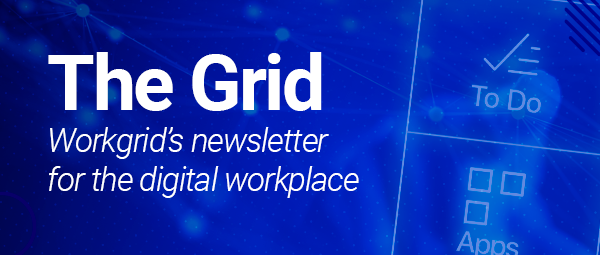How do AI Agents work?
AI agents are changing the relationship between employees and their digital workplaces. But how exactly do these intelligent agents work to provide a faster, smarter, and more efficient day? In this blog, we will explore the evolution of AI Agents and illustrate how solutions like Workgrid are simplifying the complex and elevating the employee experience.
What is an AI Agent?
If you'd asked this question a year ago, the answer might have been different. Today, AI Agents are defined in several ways. Some purists see them as fully autonomous systems that operate independently, executing complex tasks across multiple platforms.
Others use the term to describe systems that manage predefined workflows to help complete user tasks.
In a more balanced view, AI Agents are intelligent systems that automate tasks, assist employees, and make decisions based on natural language inputs. They serve as a bridge between employees and enterprise systems, allowing for seamless interaction and task completion with minimal manual effort.
How AI Agents Work: The Core Functionality
The functionality of AI Agents can be broken into three key pillars, each playing a critical role in their effectiveness.
Natural Language Processing
Reasoning and Decision Making
Response Generation, Automation, and Interaction
Step One: Natural Language Processing
The first step to proper communication is being understood. This is where AI Agents first depart from legacy chat interfaces based on key word matching. AI agents deeply analyze user input. This is done via the use of natural language processing (NLP). For example, a typed command (i.e. utterance) into an interface allows for the instructions to be transformed in several ways:
Text pre-processing: Breaking down an utterance into core understandable components.
Tokenization: Breaking down an utterance into smaller units; these would be single or series or words or sentences.
Removing stop words: Distilling down an utterance by removing stop words (e.g. is, like, and).
Lemmatization and Stemming: Reducing the words in an utterance to their base form – e.g. ‘running’ becomes ‘run’.
There would be subsequent steps of language detection (or even translation) depending on the capabilities of the agent to ensure the user is understood. Next, parts of speech would be segmented and assigned for nouns, adjectives, verbs, etc. The processes to define named entity recognition (NER) would occur to identify intent and entities (e.g. people, titles, locations, etc.). This process aids in understanding what the user is attempting to interact with or discover. Additionally, it would extract key information (e.g., dates, names, applications, or specific tasks). For example, if an employee types, “What’s the status of my expense report?” the AI Agent identifies the request, proper systems, and gathers relevant data.
Since AI Agents also need to gauge emotions of the user, this is where sentiment analysis comes in to determine if the utterance is positive, negative, or neutral. Just like in human-to-human communication emotional insight is important and complemented by the structure of the words. At this stage processes like the following may play a role.
Dependency parsing: Analyzing the grammatical structure of an utterance with understanding of word relationships.
Coreference resolution: Linking of different terms that might be referring to the same entity.
When it comes to understanding what the user wants, the AI Agents determine intent recognition and slot filling. It identifies the purpose behind your message, e.g. gathering a PTO balance, and extracts essential details, such as time-off, balances, accruals to serve the user in full.
We take for granted the human ability to comprehend and communicate. For computers these robust NLP processes aid in ensuring user intent delivers meaningful outcomes. By breaking down complex utterances the next phase can begin, which is reasoning and decision making. This is where AI Agents truly begin to reduce digital friction and empower organizations to operate more efficiently. Their ability to process inputs, validate tasks, execute actions, and improve continuously makes them indispensable.
Step Two: Reasoning and Decision Making
In this second stage, the AI Assistant would process the information it has understood and make decisions for an AI Agent to be invoked. This involves interpreting the analyzed intent and establishing context to determine the most suitable course of action.
Initially, the system employs enumerative reasoning and a series of retrieval-augmented generation (RAG) techniques across structured and unstructured knowledge sources, automated workflows, and applications. This is an iterative process that may include accessing databases, applying logic based on predefined rules, reasoning, and synthesizing information from multiple files and applications. Additionally, the system can utilize generative AI to provide predictions or craft solutions to fulfill the user's request effectively. This ‘knowledge chain’ effectively acts as the brain of the AI agent, interpreting the understood information and plotting a course of action.
Step Three: Response Generation, Automation, and Interaction
The final stage involves crafting and delivering a response to the user. The output could include content generation, the execution of a task, or action, a summary of results or steps performed, or even a recommendation.
These three components work together to create a comprehensive system capable of understanding, processing, and interacting with users in a meaningful way.
Key Benefits of AI Agents in Action
AI Agents are transforming the employee experience by seamlessly integrating into the digital workplace. They bring numerous benefits, including streamlining operations and providing valuable support to employees. Here are some of the key advantages AI Agents offer:
Simplified Workflows: By automating boring, arduous, and repetitive tasks, employees can focus on higher-value work.
Real-Time Assistance: Employees receive instant support, boosting productivity and satisfaction.
Continuous Optimization: AI Agents can easily evolve in utility and operations. This ensures they remain relevant to organizational needs and can be adjusted easily as appropriate business use guidelines change.
What's Next for AI Agents?
AI Agents are not just tools; they are strategic assets transforming the way organizations function. By simplifying processes, enhancing user experiences, and scaling effortlessly. Solutions like Workgrid are setting the standard for building AI Agents that introduce intelligent automation in the workplace.
Understanding how AI Agents work gives a glimpse into the future of work. From processing user inputs to streamlining operations and unlocking new possibilities. If you’re ready to embrace the power of AI Agents, start with a solution that allows you to build AI Agents tailored to your business needs.




